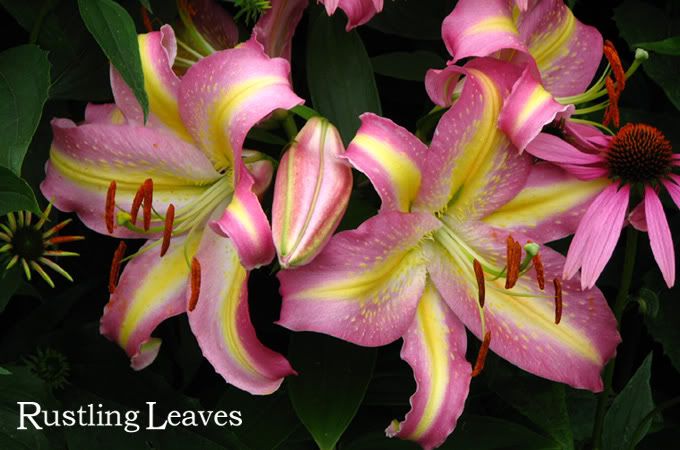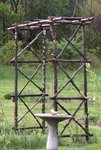Monday, April 16, 2007
The other Iris
I think of this section of plants as the leftovers, the hodgepodge of exhaustion that are the second choice at plant sales for most folks, after the sexier stable mates of Beardeds and other Iris are gone. I'm not going to go on and on about how great or terrific these are and how each could be an essential and vital element in any garden. I'm just not. But I have grown all of them and found something admirable and desirable in each of them.
Whenever I hear the word "flag" used in relation to Iris, Iris pseudacorus is the first plant that comes to mind. Cleverly named "Yellow Flag", it is an easy and dependable grower, adaptable to a wide range of habitats and growing well under normal garden conditions. Its favorite environment is aquatic and it thrives in moist, wet, marsh, bog, and water-saturated soils. I haven't grown many of the water-loving Irises but from my experience and reading more, it can tolerate deeper waters than the rest. But don't think water is a crucial component for it and necessary for optimum health, it makes a fine garden plant when landlocked. Mine is the variety 'Sun Cascade', a double flowered selection that I'm not crazy about. My preference with Iris is for single flowers so my 'Sun Cascade' receives nothing special from me. Planted at the base of a Cercis canadensis (Redbud), it fills the void, superbly I grudgingly admit, between soil and lower branches. It is a difficult and trying site for most plants, with poor soil and an unending mashing of small and large rocks but the Iris doesn't care. It flowers reliably and abundantly each year and its foliage remains strong and blemish-free all season. Oh dear, it sounds like I'm liking it.
One of the floral details I like most about pseudacorus is a fine line of brown that is etched through its lower petals, the falls. Looking like its been painted by an artist using a feather for a brush, it moves an ordinary yellow flower into something more. This line of distinction is even more accentuated in the lighter primrose-colored varieties. If the regular ones are sun-colored then these are surely moon-glowed. Some may see them as too pale and washed-out, bleached by the sun and a mockery of it but I don't care, they are my favorites.
Originating in the Lancashire countryside at Holden Clough Nursery is the surprisingly named Iris, 'Holden Clough'. Arising as an unknown hybrid or a deeply held secret, it is strongly apparent that pseudacorus is one of its parents. Similar in leaf but on a smaller scale, it has grown well. I never had great expectations for it because of a lack of close association and experience with it. But it's here now and doing fine, helping to fill a void during others' bloom cycles. Lost in the landscape at a distance, its true place is up close, where the intricate play of brown drawn on gold can be admired. If pattern and tone are your vice, then this is your fix.
I have grown Iris foetidissima for many years, decades I confess, and appreciate its virtues. Chief among these is its adaptability for growing in shade, a difficult assignment for most plants. That it prefers such a location is noteworthy and its ability to compete with the surface roots of trees is stellar. Its leaves are so smooth they seem plastic and make a great contrast to other shade lovers. It has two vices that must be mentioned if you are considering this plant. The first fault can be deciphered from its name - foetidissima - to smell unpleasant, rank, or fetid. The odor is released when the leaves are crushed or broken, something I'm not in the habit of doing with my other plants so why this one? I don't find it to be strong or especially rank but to each their own nose. The other characteristic is not as easily excused: small ho-hum flowers that put the plain in Jane. But you should try to encourage as much flowering as possible because of its other great virtue - colorful seeds. Opening in the fall, the seedpods gaily display their bounty in shades of deep orange; that there are also white and golden seeded varieties seals the deal. As flashy as the flowers are modest, the seeds brighten up a shaded fall garden. Leave them on the plants and in time you'll soon have seedlings growing, creating drifts more becoming than anything I've done. As easy to transplant as other Iris, use them to fill holes or for profit or barter or even compost, there will be more. It reproduces without becoming weedy and I like that.
I have scant experience with Spuria Iris, one plant I confess, but I've liked what I've seen. Great height is their hallmark and with their rigidly erect leaves I thought an arrow was buried up to its fletching. Mine flowered blue and purple mixed with bronze, presented for inspection without any bending from me. Not loving wet soils, they thrived on a well-drained slope. I don't currently have one but that doesn't mean I'm not looking. Most varieties are purple but other colors are making inroads so let's encourage the breeders to continue refining and expanding their range by speaking well of them in greater than hushed tones. The Iris, silly.
If Iris could be a canine, then brevicaulis would be a lap dog. Very short, no more than a foot, this moisture-lover meanders on long rhizomes about the ground, popping up new sections of itself quite a distance from the rest, as if playing a hiding game with itself and me. With palest blue flowers in spring, I can't help but like it, a plant with humor amidst the beauty.
There is a range of spring-blooming Iris available as bulbs for planting in the fall. One of my weaknesses is small plants, the things that are wee, and when they are replicas of larger plants, so much the better. I'll call them the little ones and they come in all the classic Iris colors: blue, purple, violet, yellow, and white. I had a discouraging experience with them once and it has kept me from growing them again. I had a range of colors and planted them into terracotta containers, imagining them growing into perfect displays of Irisdom. The garden snails had other plans for those plants and easily overran all my attempts to prevent them. I thought Irises were impervious to animal onslaughts but they must have better e-mail, servers, and cellulars than me. I have gotten over it, mostly, and should reintroduce myself to these miniatures.
My newest acquisition is Iris versicolor, a native. This will be its first year of flowering for me and I'm eagerly waiting for its palest of blue flowers to brighten a shaded bed. I had no hesitation jettisoning some Hostas to make room for it. As it increases in size and I augment it with others, maybe the whole bed will become Hosta-free.
I think as I reread this post my new motto must be: More Iris Please.
Tomorrow: PCN Iris reprise
Posted by Craig at 3:47 AM
Labels: holden clough, iris, iris brevicaulis, iris foetidissima, iris pseudacorus, Iris spuria, yellow flag
Hotlinks: Ma.gnolia DiggIt! Del.icio.us Blinklist Yahoo Web Furl Technorati Simpy Spurl Reddit Google Newsvine
Subscribe to:
Post Comments (Atom)








2 Comments:
I. pseudoacorus is considered invasive in some circles.
Highly energetic post, I loved that bit. Will there be a part 2?
Here is my web-site Marc Primo
Post a Comment